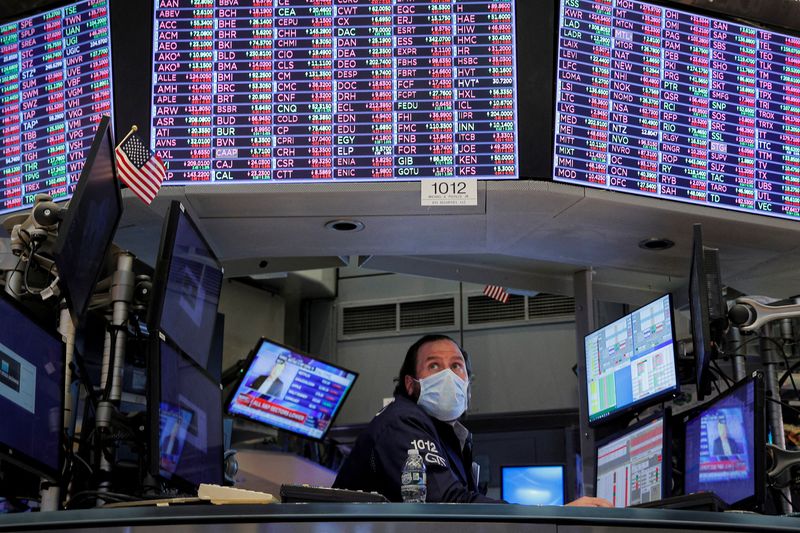By Lewis Krauskopf, Shreyashi Sanyal and Bansari Mayur Kamdar
(Reuters) - Wall Street's main indexes ended sharply lower on Wednesday, with the tech-heavy Nasdaq confirming it was in a correction, after a diverse set of corporate earnings and as investors continued to worry about higher U.S. Treasury yields and the Federal Reserve tightening monetary policy.
The Nasdaq ended down 10.7% from its Nov. 19 closing record high, as stocks sold off into the market close. A correction is confirmed when an index closes 10% or more below its record closing level.
The Nasdaq's last correction was in early 2021, when the tech-heavy index fell more than 10% from Feb. 12 to March 8. It was the fourth time in the two years since the coronavirus pandemic shook global markets that the index has found itself in a correction.
On Wednesday, Apple shares (NASDAQ:AAPL) fell 2.1%, weighing most on the Nasdaq, while declines in Tesla (NASDAQ:TSLA) and Amazon (NASDAQ:AMZN) also dragged on the index.
Stocks have gotten off to a rocky start in 2022, as a fast rise in Treasury yields amid concerns the Fed will become aggressive in controlling inflation has particularly hit tech and growth shares. The benchmark S&P 500 is down about 5% so far this year.
“Any beginning of tightening often results in significant volatility and I think there is always that risk that there is a policy error and it ends the economic cycle," said Kristina Hooper, chief global market strategist at Invesco. "So we just have a lot of apprehension.”
The Dow Jones Industrial Average fell 339.82 points, or 0.96%, to 35,028.65, the S&P 500 lost 44.35 points, or 0.97%, to 4,532.76 and the Nasdaq Composite dropped 166.64 points, or 1.15%, to 14,340.26.
Consumer discretionary fell most among S&P 500 sectors, dropping 1.8%, while financials dropped about 1.7% and technology slid 1.4%.
The small-cap Russell 2000 fell 1.6%.
Stocks had tumbled on Tuesday, with the Nasdaq falling 2.6%, after weak results from Goldman Sachs (NYSE:GS) and a spike in Treasury yields. U.S. Treasury yields eased on Wednesday from two-year highs.
Investors are looking to next week's Fed policy meeting for more clarity on central bankers' plans to rein in inflation. Data last week showed U.S. consumer prices increased solidly in December, culminating in the largest annual rise in inflation in nearly four decades.
"There's a fair amount of anxiety in terms of how the next three to six months are going to play out with a rate-hike cycle set to start likely in March," said Michael James, managing director of equity trading at Wedbush Securities in Los Angeles.
In company news, shares of Procter & Gamble (NYSE:PG) rose 3.4% after the consumer goods company bumped up its annual sales forecast.
Bank of America Corp (NYSE:BAC) reported a better-than-expected 30% jump in quarterly profit, while Morgan Stanley (NYSE:MS) also reported fourth-quarter profit which beat market expectations, following uneven results from other banks. Bank of America shares rose 0.4%, while Morgan Stanley shares gained 1.8%.
Declining issues outnumbered advancing ones on the NYSE by a 2.06-to-1 ratio; on Nasdaq, a 2.09-to-1 ratio favored decliners.

The S&P 500 posted 13 new 52-week highs and seven new lows; the Nasdaq Composite recorded 23 new highs and 630 new lows.
About 11.4 billion shares changed hands in U.S. exchanges, compared with the 10 billion daily average over the last 20 sessions.